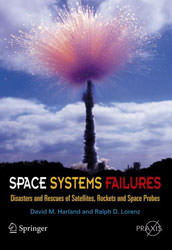
High risk activities and aerospace are almost synonymous. Failures do occur. Who will ever forget the Hubble Telescope’s erroneously ground mirror? More visually spectacular are the launchers that explode immediately after launch, as did a Delta II in 1997. There’s also the high gain antenna of the Galileo spacecraft, which never opened, or the resounding thud of the Genesis spacecraft when its re-entry parachute failed. Not all are design errors, as the first accredited space collision saw the Cerise mircosatellite get decapitated. Less awe inspiring are ones like NOAA’s N-Prime, which was allowed to slip off its work platform within the factory. Successes do keep us trying, but the failures keep us cautious.
Writing about space failures can easily slip into grandiose hyperbole, but Dave Harland and Ralph Lorenz don’t go there. Their mission is to preserve a little of the industry knowledge that keeps sliding away when mentors retire or experts seek new pastures. Their book has two parts, both of which focus entirely on satellites and space probes, to the omission of manned flights.
The first part takes a chronological look at launchers, most of their failures, as well as much of their evolution. A quick synopsis for the 1950s converges onto the Ariane, Atlas and Delta systems of today. Not forgotten are foreign and niche market players like the Long March, Japan’s H series and OSC’s Pegasus. Very little mention is made of the USSR’s efforts. Sections examine each launcher in turn, often with the inclusion of significant dates and particular failures. For the failures, sometimes the authors identify the errant sub-system, but not often. Also, the topic can wander, as when talking about the economies of data relay systems or describing satellite repair during the early shuttle program. In all, this section is a good synopsis of launcher evolution and accompanying failures.
The second part of the book goes through various systems of satellites and space probes that have failed. Instead of using a chronological separation, the authors make divisions by system according to root causes; either propulsion, electrical, or other. As corrective measures can be found, the authors also describe many of the work-arounds. For example, an ingenious recovery team sent HGS 1 on lunar flybys en route to a geostationary orbit. In acknowledgement of these near miraculous events, the authors continually stress that the extremes of space make a broad and deep support team rewarding, if not essential.
As well, throughout the book, the authors attempt to instill some reasoning into risk management. In particular, how does one balance over-engineering against under-funding? The occasional arm chair warrior statement arises, such how $2 worth of a better grade of metal would have saved months of a ground crew’s diligent rescue efforts. Some process improvements get mentioned, such as managers who reward individuals for raising design problems at any stage of a mission. But, this book is much more a recitation of the facts and often the underlying causes.
Though the authors do stay on topic, side issues arise. For example, they discuss the effects on insurance agencies when a series of failures occur. Then there’s the discussion on the suitability of space walkers using the shuttle to fix satellites, the result being the practise was deemed not cost effective. As a result of all the data and many photographs, the reader will quickly appreciate the challenges that come with any space activity and the continual progress being made in the industry. Nevertheless with this book readers will still just be grazing the edge of the fields of risk management and quality control rather than becoming proficient in either.
Reading a book on failure is not for the faint of heart. But far better it is to be a little faint of heart than being ignorant of the challenges. David Harland and Ralph Lorenz in their book Space Systems Failures present the darker side that counters our thrust into space. Critical failures can quickly arise due to the myriad of logic switches, the demands of mechanical systems and the exactness of computer code. However, as long as we keep learning from our mistakes, our hearts will keep strengthening.
Review by Mark Mortimer
Read more reviews online, or purchase a copy from Amazon.com.
